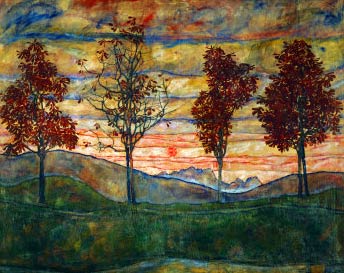Four Trees was a stunning landscape painting by Egon Schiele in 1917. It can now be found at the Belvedere in Vienna, Austria, a city that proved so important to the artist's developent.
Schiele's Four Trees has great depth through contrasting lighting which draws attention to the mountains and bright sun in the background. Some believe that the trees on the edges of the painting are healthier to portray a belief from the artist that those who follow a more original route in life would be happier than those who chose more conservatively. Four Trees (Vier Bäume) focuses the eye on a stunning sun sitting behind mountains in the background of the painting, whilst trees dot evenly across the foreground of this landscape painting. The contrast between brightness and darkness in this artwork have made it popular for Egon Schiele fans, and it has become one of the most reproduced of all paintings from his short but productive career.
There has been some discussion that the varying conditions of the trees symbolise the healthy approach of being on the outside of society as opposed to following a more mainstream, conservative route through life. Whilst this painting remains Schiele's most famous landscape painting, other notable contributions included Yellow City, House with Shingles and Setting Sun. Discussion of Schiele's short but illustrious oeuvre is dominated by his portraits. Landscape paintings do extend to a large segment of his work, and also serve as an intriguing comparison to Klimt's own landscape paintings. Schiele's landscapes are considered by many to be a significant contribution to the school of European nature painting. They also underline the mastery of the artist and the way in which he could apply his expressive style to muliple genres.
Expressionist artists such as Schiele would communicate emotions such as betrayal, sorrow, pride and passion in their work. Four Trees shows this perfectly, converting a standard landscape scene into a frenzy of colour and adapted form. It was around this time in the early 20th century when many lives were struggling, making this form of art an escape and an attraction in contrast to their own reality. Four Trees represents us a trees, with those on the outside of society being happier and healthier. In a way, this is a self-portrait, or at least a personal reflection from Egon on how he saw himself in relation to others. There is also a clever use of perspective which intrigues the eye and leaves more detail than you will initially have seen. A careful study of the different items in this landscape reveal that the artist has gone away from normal standards of landscape paintings in order to create this augmented reality.
Head to the Belvedere, in Vienna, Austria to see Four Trees in person. It truly is a stunning artwork, perhaps one of the artist's best within this genre. Schiele decision to turn to landscape and cityscape art proved inspired, and whilst he remains most famous for his portraits and self-portraits, his work in the outdoors has become some of the most reproduced of his career. A visit to Wien, as the city is known locally, will also bring the Leopold Museum to your attention which itself holds the most impressive collection of Schiele paintings anywhere in the world, making Vienna an essential destination for followers of the artist. They themselves have over two hundred oil paintings, watercolours and drawings from his career, providing an impressive share of his oeuvre within the same city in which he had originally made his name all those years ago.




